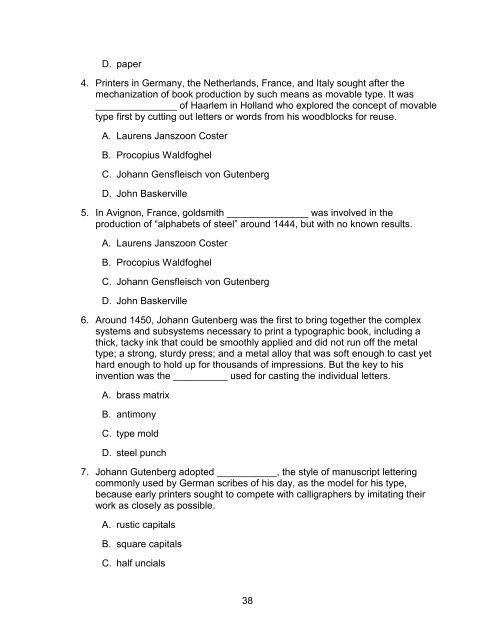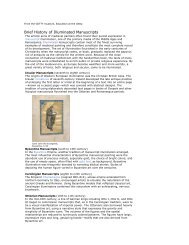- Page 1 and 2: Study Guide to Accompany Meggs’ H
- Page 3 and 4: Table of Contents Acknowledgements
- Page 5 and 6: Acknowledgments I would like to tha
- Page 7 and 8: Introduction, 4 Prehistoric visual
- Page 9 and 10: Multiple Choice Chapter 1 - Study Q
- Page 11 and 12: 9. Throughout the world, from Afric
- Page 13 and 14: C. annual records of crop productio
- Page 15 and 16: E. A tall, geometric, totem-like Eg
- Page 17 and 18: Introduction, 18 Cretan pictographs
- Page 19 and 20: Phoenicians, page 19 Cadmus of Mile
- Page 21 and 22: A. the most important words in a se
- Page 23 and 24: A. codex B. rotulus C. scroll D. di
- Page 25 and 26: 1. The invention of the alphabet an
- Page 27 and 28: Dharani, page 36 Accordion-style bo
- Page 29 and 30: was also called bone-and-shell scri
- Page 31 and 32: Matching I. Match the key term with
- Page 33 and 34: Introduction, 42 The classical styl
- Page 35 and 36: Multiple Choice Chapter 4 - Study Q
- Page 37 and 38: 8. During the Romanesque period (A.
- Page 39 and 40: Matching C. Les très riches heures
- Page 41 and 42: Introduction, 64 Early European blo
- Page 43: Multiple Choice Chapter 5 - Study Q
- Page 47 and 48: True/False E. In casting type, the
- Page 49 and 50: Introduction, 78 Chapter 6 - The Ge
- Page 51 and 52: Multiple Choice Chapter 6 - Study Q
- Page 53 and 54: D. Aesop’s Vita et fabulae (Aesop
- Page 55 and 56: page design, and makeup of books. T
- Page 57 and 58: Introduction, 94 Chapter 7 - Renais
- Page 59 and 60: Multiple Choice Chapter 7 - Study Q
- Page 61 and 62: per line of a given measure was ach
- Page 63 and 64: B. copperplate engravings C. delica
- Page 65 and 66: 1. Francesco da Bologna, surnamed G
- Page 67 and 68: B. Erhard Ratdolt C. Stephen and Ma
- Page 69 and 70: Axes, page 125 Cartesian coordinate
- Page 71 and 72: Multiple Choice Chapter 8 - Study Q
- Page 73 and 74: 8. Baskerville’s type design repr
- Page 75 and 76: B. classics by Virgil C. plays by M
- Page 77 and 78: 3. Fig. 8-14 ____ A. John Baskervil
- Page 79 and 80: Egyptian type, page 137, (Fig. 9-3)
- Page 81 and 82: Darius Wells (1800-1875), page 139
- Page 83 and 84: Multiple Choice Chapter 9 - Study Q
- Page 85 and 86: D. Darius Wells 8. In 1834, _______
- Page 87 and 88: following advances in graphic desig
- Page 89 and 90: A. Harper’s New Monthly Magazine
- Page 91 and 92: Matching I. Match the key people wi
- Page 93 and 94: Chapter 10 - The Arts and Crafts Mo
- Page 95 and 96:
Arts and Crafts Exhibition Society,
- Page 97 and 98:
Multiple Choice Chapter 10 - Study
- Page 99 and 100:
C. The use of seven different color
- Page 101 and 102:
15. __________ established Eragny P
- Page 103 and 104:
II. Match each of the images shown
- Page 105 and 106:
Art nouveau, page 194 Historicism,
- Page 107 and 108:
Henri de Toulouse-Lautrec (1864-190
- Page 109 and 110:
C. Celtic ornament D. Assyrian moti
- Page 111 and 112:
11. A member of the Flemish Group o
- Page 113 and 114:
6. The coloring book style of Aubre
- Page 115 and 116:
Chapter 12 - The Genesis of Twentie
- Page 117 and 118:
Multiple Choice Chapter 12 - Study
- Page 119 and 120:
epresent the first use of sans-seri
- Page 121 and 122:
B. Peter Behrens C. Koloman Moser 1
- Page 123 and 124:
Photomontage, page 259 Merz, page 2
- Page 125 and 126:
Multiple Choice Chapter 13 - Study
- Page 127 and 128:
press: a head wrapped in newspaper
- Page 129 and 130:
the authority of the military, educ
- Page 131 and 132:
Introduction, 269 Plakatstil, 270 S
- Page 133 and 134:
Multiple Choice Chapter 14 - Study
- Page 135 and 136:
E. surrealsim 8. ____________ of Mu
- Page 137 and 138:
3. Fig. 14-8 ______________________
- Page 139 and 140:
Dev\tsil (Nine Forces), page 307 Ke
- Page 141 and 142:
D. Basic Concepts of Form-Making 4.
- Page 143 and 144:
B. Théo van Doesburg C. Alexander
- Page 145 and 146:
3. Alexander Rodchenko designed thi
- Page 147 and 148:
Experimenta Typographica, page 333,
- Page 149 and 150:
Multiple Choice Chapter 16 - Study
- Page 151 and 152:
6. Much of the creative innovation
- Page 153 and 154:
layouts and de Stijl’s insistence
- Page 155 and 156:
Introduction, 336 Chapter 17 - The
- Page 157 and 158:
Multiple Choice Chapter 17 - Study
- Page 159 and 160:
C. Joseph Binder D. Jean Carlu 6. I
- Page 161 and 162:
11. An important milestone in the v
- Page 163 and 164:
Introduction, 356 Chapter 18 - The
- Page 165 and 166:
Multiple Choice Chapter 18 - Study
- Page 167 and 168:
A. Adrian Frutiger B. Max Miedinger
- Page 169 and 170:
ased on the elemental graphic-form
- Page 171 and 172:
Introduction, 374 Pioneers of the N
- Page 173 and 174:
Multiple Choice Chapter 19 - Study
- Page 175 and 176:
A. Paul Rand B. Saul Bass C. Alvin
- Page 177 and 178:
format and grid became the norm. Am
- Page 179 and 180:
2. Visual/verbal syntax ____ 3. Fig
- Page 181 and 182:
Adriano Olivetti (1901-1970), page
- Page 183 and 184:
Multiple Choice Chapter 20 - Study
- Page 185 and 186:
A. Herbert Matter B. Norman Ives C.
- Page 187 and 188:
spread a generic conformity across
- Page 189 and 190:
Matching A. Georg Olden B. Massimo
- Page 191 and 192:
Key People and Their Major Contribu
- Page 193 and 194:
Multiple Choice Chapter 21 - Study
- Page 195 and 196:
developed for a Mademoiselle poster
- Page 197 and 198:
12. The vibrant contrasting colors
- Page 199 and 200:
Chapter 22 - National Visions withi
- Page 201 and 202:
Multiple Choice Chapter 22 - Study
- Page 203 and 204:
Biennial Exhibition of Prints in To
- Page 205 and 206:
designers, such as ______________,
- Page 207 and 208:
A. Masuda Tadashi B. Takenobu Igara
- Page 209 and 210:
Key People and Their Major Contribu
- Page 211 and 212:
Multiple Choice Chapter 23 - Study
- Page 213 and 214:
widespread influence on typographic
- Page 215 and 216:
C. Herbert Matter D. Walter Herdeg
- Page 217 and 218:
II. Identify the postmodern movemen
- Page 219 and 220:
Desktop publishing, page 490 Émigr
- Page 221 and 222:
Hideki Nakajima (b. 1961), page 508
- Page 223 and 224:
Multiple Choice Chapter 24 - Study
- Page 225 and 226:
designers vigorously committed to c
- Page 227 and 228:
B. Matthew Carter C. Robert Slimbac
- Page 229 and 230:
from the image on the cover, he put
- Page 231 and 232:
4. Susan Kare ____ 5. Carol Twombly
- Page 233 and 234:
of interactive media who believed d
- Page 235 and 236:
Matching I. II. III. 1. determinati
- Page 237 and 238:
Multiple Choice 1. B - sounds 2. C
- Page 239 and 240:
Multiple Choice 1. A - oil paint 2.
- Page 241 and 242:
Multiple Choice 1. C - copisti 2. A
- Page 243 and 244:
Multiple Choice 1. A - Devotional p
- Page 245 and 246:
Multiple Choice Chapter 6 - Answer
- Page 247 and 248:
Multiple Choice 1. D - Venice 2. A
- Page 249 and 250:
II. 4. Fig. 7-27: Geoffroy Tory, pa
- Page 251 and 252:
4. True 5. False 6. False 7. False
- Page 253 and 254:
23. B - Century 24. A - market rese
- Page 255 and 256:
Multiple Choice Chapter 10 - Answer
- Page 257 and 258:
Multiple Choice 1. B - screen paint
- Page 259 and 260:
II. 1. Fig. 11-3: E - Kitagawa Utam
- Page 261 and 262:
II. 6. Fig. 12-30: Josef Hoffmann,
- Page 263 and 264:
III. 1. collage: D 2. manifesto: A
- Page 265 and 266:
II. 3. Fig. 14-8: Hans Rudi Erdt, P
- Page 267 and 268:
III. 1. C - Novyi lef (Left Front o
- Page 269 and 270:
Multiple Choice 1. B - Armory Show
- Page 271 and 272:
Multiple Choice Chapter 18 - Answer
- Page 273 and 274:
2. B - Figurative typography 3. C -
- Page 275 and 276:
2. B - corporate identity 3. A - an
- Page 277 and 278:
Multiple Choice 1. B - Pentagram’
- Page 279 and 280:
Multiple Choice 1. B - mannerism 2.
- Page 281 and 282:
Multiple Choice 1. C - phototype 2.
- Page 283 and 284:
VI. 1. linear series - C 2. spatial




